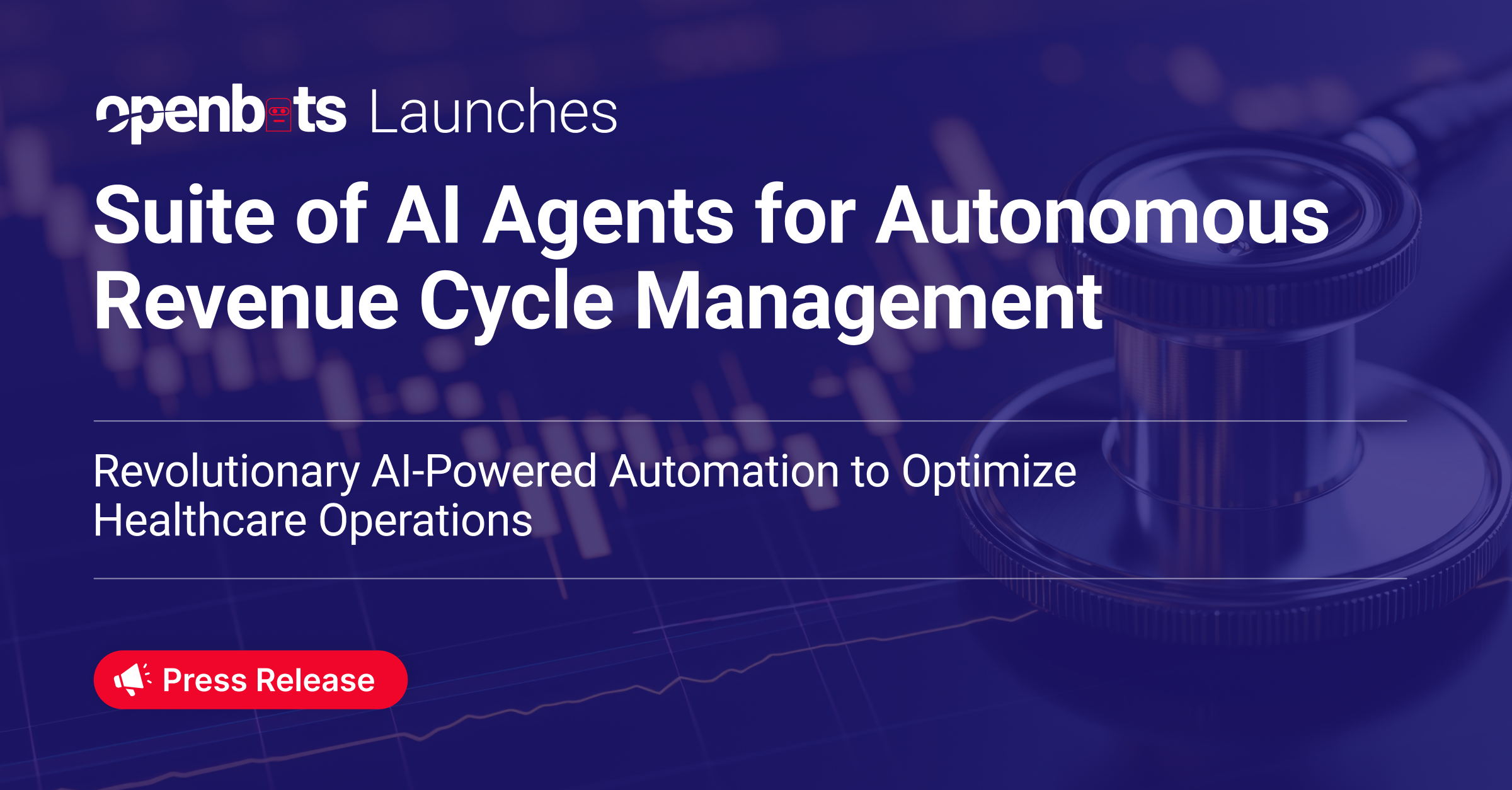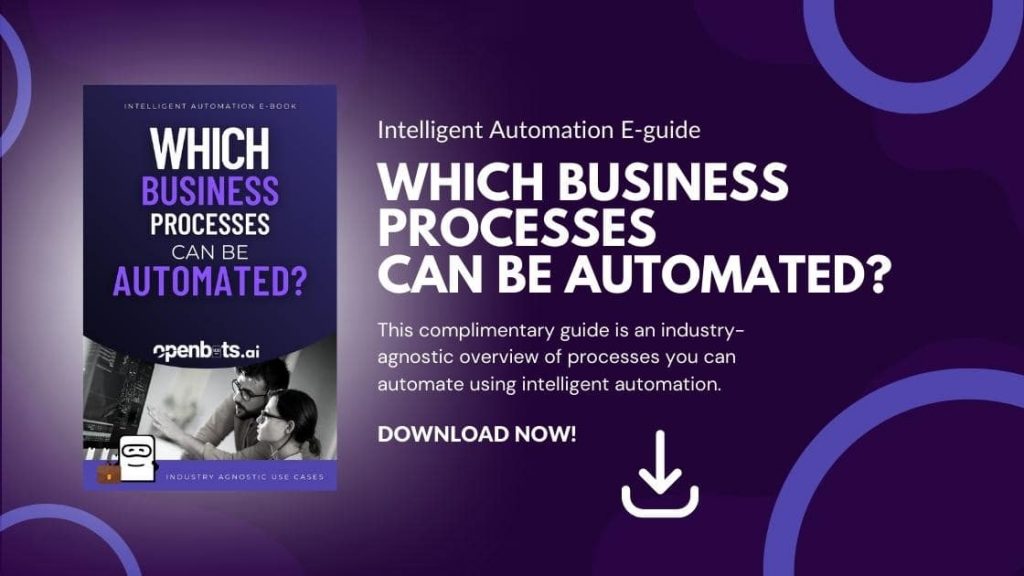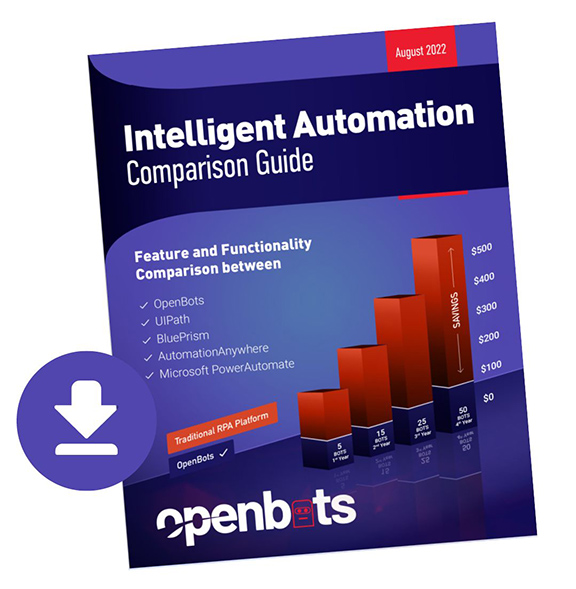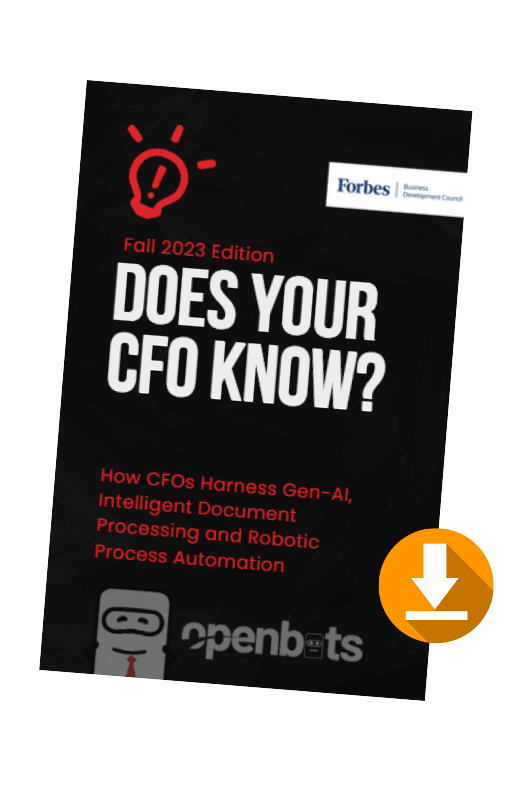Top Objections to Robotic Process Automation in Financial Services
 by
Jason Dzamba - November 15, 2021
by
Jason Dzamba - November 15, 2021
Are you interested in using robotic process automation in financial services?
The promise from RPA vendors of increased organizational efficiency and employee productivity is exciting on paper, but there are many pieces required to reap the benefits of RPA technology. Is your firm correctly prepared to implement RPA successfully in your organization?
In this article, we’ll cover the top business objections to implementing RPA in financial services. After reading, you’ll gain a deep insight into the main issues firms face with launching and scaling RPA programs. We’ll also provide our top two solutions to these objections.
Robotic Process Automation in Financial Services Business Objections
Many firms are using robotic process automation (RPA) in financial services to improve their efficiency and enable their employees to focus on valuable, high-IQ tasks.
What determines the success of an RPA program in the financial sector?
According to Gabriel Skelton, an automation consultant specializing in financial services, “You need to have an effective maintenance plan for automations and bots to have a successful RPA program.”
RPA is one of the fastest-growing enterprise technologies in the market. According to Gartner, the worldwide robotic software automation market grew by 63% in 2018. Now it’s over 2 billion and will continue to grow well into 2024, as stated in a recent press release.
In the RPA industry, there is a difference between “renting” a bot and owning it. When you own a bot outright, you’re able to focus your budget on developing and maintaining it, but this is still a relatively new concept in the RPA industry.
As we’ll discuss, choosing RPA tools that help your firm scale is crucial for long-term success with RPA.
1. Don’t Understand the Capabilities of RPA Technology
In theory, RPA is relatively simple—it uses bots or digital workers to automate a manual task that an employee typically carries out.
Still, RPA is an enterprise technology that many potential adopters don’t fully understand. Implementing it correctly isn’t immediate—it takes time, effort, resources, and stakeholder collaboration from various levels within a firm.
After a firm automates its first process and gets proof of value, it becomes easier to see the potential impact that it will have on their entire business.
RPA technology is simply a suite of tools used to solve business challenges. When your firm has the proper perception of RPA implementation, it becomes more a question of where you can use it rather than why you would use it.
2. ROI Can Be Difficult to Gauge
Leaders can be quick to measure the ROI by headcount and FTE savings, but it’s not apples-to-apples. A plan for a large-scale RPA program rollout is excellent in theory, but only an estimate.
The first few automations are the easiest to build and will be low-hanging fruit, and the ROI will be clear and immediate. The processes will become more nuanced when you move past the first 5, 10, and 20 automations and won’t always translate into direct FTE savings.
Many firms understand the benefits of RPA in banking, but it can be harder to justify the cost of complex automations. They require more development hours to build and break down more often—many CIOs question whether it’s worth the investment.
It’s a challenge for an RPA technical architect to balance ROI and manage the budget. They have the most insight into maximizing ROI, but they’re not usually the decision-makers in their firm.
When you pay to rent a bot on top of development and maintenance, ROI gets buried with the budget. Firms view muddy ROI as a shortcoming of RPA, but the culprit is the licensing models of traditional RPA platforms, not the technology itself.
3. Unclear How to Utilize a Bot
How to use a bot in an organization is a conversation had at many levels. For firms with an RPA program, the responsibilities are clear between human and bot workers.
Firms getting started with RPA often have a point of contention on a bot’s role in their organization. How will they feel about working alongside a digital worker? Will they fire employees and replace them with bots? These are concerns every firm will have to address.
Many companies think that a bot will directly replace a full-time employee, but it’s rarely a 1-to-1 relationship. Mundane tasks that are high-volume are prone to errors. Using a bot to automate these tasks allows the employee to focus on creating value for their firm beyond the redundancy of data entry.
The value from automations is often consistency rather than FTE savings. Large-scale organizations, for instance, have thousands of employees that need access to Microsoft office. Using a bot to assign software licenses can help prevent errors like assigning senior-level permissions to a junior employee.
The purpose of a bot is to help human workers in a support role. The firms that find the most success with RPA use it to empower human workers rather than replace them.
4. Licensing Costs Limit Scaling
A business with many automations is up against a scaling threshold—they want to invest in their RPA program, but they’re at a crossroads with licensing and ROI.
Firms that have 100 bots or more will have a Center of Excellence (COE). Various departments or lines of business will have to work with the COE when they want to build an automation to get budget approval.
More and more, COEs are denying automations. When they look at their bottom line, it’s no longer cost-effective to automate. Why are processes getting rejected? Bot-licensing diminishes the ROI from future automations and strips away the ability to scale.
If you’re a CTO with a license-heavy RPA platform, there are ways around these scaling issues. Some leaders keep their core automations running and build new ones on a zero-license platform like OpenBots. Using a multi-vendor strategy like this ensures the automations are ROI-positive.
There is also the trend of large firms turning off automations and moving them over to a license-free platform. When they transition, the benefits are immediate.
Imagine your company is spending $10-$15K on annual licensing for each bot, and you turn off those costs like a light switch on 5, 10, then 50 bots. You’ll suddenly have thousands back in your pocket to invest in new automations, and your COE will be more likely to approve them.
5. Already Tied to an Existing Platform
Firms tend to categorize the industry as a whole. Looking at other RPA platforms, they think they don’t need it because they already have it. The perception is that every solution is the same.
Firms implementing RPA in finance have already gone through the legwork of vetting the RPA platform they’re using. They know the work involved and layers of moving pieces, making them less likely to consider alternative options. They’re comfortable with what they have.
Related article: RPA Does Not Store Any Data…So Why Are You Paying So Much For It?
Using something new can raise flags as a potential security risk, and banks require a lot of due diligence to comply with regulatory and security requirements. These factors create reservations about trying something new, even if it could benefit their RPA program.
Still, firms comfortable with their platforms are automating less than they anticipated. Why isn’t RPA implementation moving faster?
The experience of RPA adopters is in stark contrast with what was promised by traditional RPA vendors. Because of this, firms often have bad taste in their mouth of the benefits of RPA, with ROI less of a factor than hoped.
6. Don’t Have Proper Development Support
You don’t have to be a hardcore developer to start building automations. RPA platforms are on the low-code spectrum and allow business professionals with minimal technical experience the ability to build automations.
This is fine for those just starting, but as mentioned, RPA is an enterprise technology that has many moving parts. Folks with some knowledge of Python and C# can custom automations to suit their organization needs, but a firm generally doesn’t have seasoned RPA developers.
Creating an RPA program isn’t a hobby or side project, but many firms treat it that way. They lack the proper development team to build automations that will take their organization to the next level.
Related article: The Case for RPA in Mid-Market Organizations
When you go solo and try to do things yourself, you can run into issues. Mainly, it’s missing opportunities to get the most from your automations. RPA developers are highly technical with deep experience that citizen developers won’t learn in an academy course or training.
Guided assistance helps ensure better quality automations that provide value for your firm. Organizations may have willing volunteers to work on an RPA project, but these rarely pan out compared to a professional program tailored to niche needs.
Solutions to Robotic Process Automation Top Objections in Financial Services
A set of objections wouldn’t be complete without solutions to these problems. Here are the top two that can help your firm move past these RPA obstacles.
Nail Down Automations with a Process Discovery
Firms have multiple stakeholders that will take part in the automation discussion. If you capture documentation upfront, firms can build their automations quickly.
Which processes should you automate in your firm?
It starts with creating a process design document (PDD) or process discovery document to map out a process from beginning to end. That document is then handed off to the development team to develop a bot around these explicit instructions.
Taking the time to document your processes from end-to-end is how you’ll create an automation schedule based on priorities, ROI, and complexity. Many potential issues can be addressed or avoided completely by a thorough process discovery.
Prove Out Value with an RPA Implementation Partner
When considering a new RPA platform, it’s best to start with a single automation build. It’s a minimal investment to prove out the value and will set the pace moving forward.
Even if your firm has an in-house development team, they may not have the experience or capacity to build effective automations. Using a partner to build your first few automations will ensure they’re done correctly and are ROI positive. Automating pieces of a complex workflow is a fantastic place to start.
How Financial Firms Get the Most From their RPA
This is a unique time for organizations that are implementing RPA in finance. Firms don’t have to remain tied to platforms that limit their ability to improve their organization. Many realize that it’s not the functionality of their RPA platform but the licensing model that makes the scalability of RPA a reality.
If firms take the time to consider a zero-bot licensing model, they’ll see not only the financial impact but also the number of automations they can build that will provide ROI at scale. If your firm is starting with RPA or already is using it, OpenBots provides a friction free approach to implementing automations.
Ready to scale your RPA in your firm? Let’s talk!

About Jason Dzamba
Director of Media Relations, Productivity Strategist, and Host of Inside the Bot Podcast, Jason uses a process-driven approach to help leaders optimize their actions and achieve their most important business objectives. His creative outlet is painting abstract art and producing music. He lives in Orlando, Florida, with his three kids.
Recent Posts
Related Blog Posts

OpenBots Launches Suite of AI Agents for Autonomous Revenue Cycle Management
OpenBots Inc. is transforming healthcare financial operations with the launch of its AI-powered suite of eight Autonomous Revenue Cycle Management (RCM) Agents…

Agentic AI in Banking: Ten Transformative Processes to Automate
The banking industry is changing rapidly with the tech revolution, and modern technologies like Agentic AI are at the centre […]

Hospital Automation – Eleven Processes You Need to Automate
Explore Hospital Automation and Eleven Processes You Need to Automate. Discover how RPA and AI are transitioning healthcare operations, patient care, and efficiency, all while maintaining a human touch.






